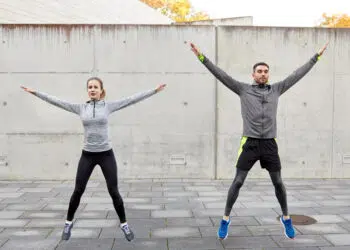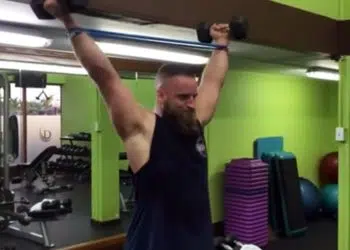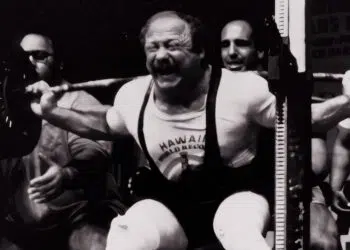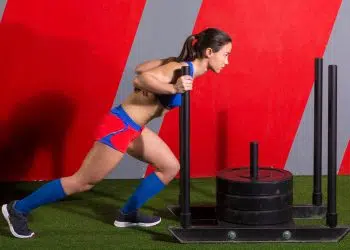When it comes to cardio and conditioning, many exercisers turn to outdoor activities like running and cycling to get the job done. Others use high-tech equipment, such as rowers, air-bikes, ellipticals, or treadmills, and do their workouts in a home or commercial gym.
However, you don’t need to do either of these things to get fit and drop some body fat. In fact, you can get a pretty good workout in just a couple of yards of space using nothing but your body weight for resistance.
In this article, we take a look at one of the most straightforward, most convenient bodyweight conditioning exercises around – seal jacks – and explain why and how to do this great move.
Seal Jacks – Muscles Worked
Seal jacks are a compound exercise, meaning they involve two or more joints and multiple muscles. In fact, it’s no exaggeration to say that seal jacks are a full-body exercise. That said, the main muscles involved in seal jacks are:
Triceps surae
Better known as your calves, the triceps surae are your gastrocnemius and soleus muscles. Jumping your feet out and back in again means your calves get a great workout from seal jacks, especially if you keep your weight on the balls of your feet.
Quadriceps
Located on the fronts of your thighs, the quadriceps are a group of four muscles. Known as the quads for short, these four muscles are the rectus femoris, vastus medialis, vastus intermedius, and vastus lateralis. The quadriceps have two functions – knee extension and hip flexion – with the former being part of doing seal jacks.
Level Up Your Fitness: Join our 💪 strong community in Fitness Volt Newsletter. Get daily inspiration, expert-backed workouts, nutrition tips, the latest in strength sports, and the support you need to reach your goals. Subscribe for free!
Hamstrings
The hamstrings oppose your quadriceps and are responsible for hip extension and knee flexion. As such, they’re involved in the jumping action of seal jacks. The hamstrings are a group of three muscles – biceps femoris, semimembranosus, and semitendinosus.
Gluteus maximus
Known as the glutes for short, this is the largest and most powerful muscle in the human body. Despite this impressive pedigree, the glutes only have one main function – hip extension. However, some glute fibers are also somewhat involved in hip abduction and rotation.
Hip abductors
The hip abductors are located on the outside of your thighs and hips. Their function is lifting your legs out and away from the midline of your body. The hip abductors are the gluteus minimus, gluteus medius, and tensor fascia latae.
Hip adductors
Opposing the hip abductors, the adductors draw your legs in and toward the midline of your body. The three hip adductor muscles are longus, brevis, and magnus, meaning longest, shortest, and biggest/widest. The adductors are located on the insides of your thighs.
Core
Core is the collective term for the muscles of your midsection. Working together like a meaty weightlifting belt, these muscles help support and stabilize your spine during seal jacks. The main muscles that make up the core are the rectus abdominis, obliques, transverse abdominis, and erector spinae.
Deltoids
The deltoids are your shoulder muscles. There are three sets of deltoid fibers – called heads – each of which has a different function. The three deltoid heads are anterior (front), medial (middle), and posterior (rear). All three deltoid heads are involved in seal jacks, but the anterior and posterior heads are the most active.
Pectoralis major
Known as the pecs for short, these are your chest muscles. Located on the front of your upper torso, the pecs are responsible for adduction and horizontal flexion of your shoulders. Swinging your arms forward at shoulder height means your pecs work pretty hard during seal jacks.
Trapezius and rhomboids
The trapezius and rhomboids are located across and between your shoulder blades. They control and stabilize your scapula bones. Opening your arms and swinging your arms backward involves both of these muscles, which invariably work together.
Cardiorespiratory system
Because seal jacks involve such a long list of muscles, they also have a pronounced effect on your heart and lungs, collectively known as the cardiorespiratory system.
All these muscles require oxygen, and your heart and lungs respond to this demand by working harder. Subsequently, your heart and breathing rate will increase during seal jacks to keep your muscles supplied with the oxygen they need to continue functioning.
How to Do Seal Jacks
Get more from seal jacks while keeping your risk of injury to a minimum by following these guidelines:
- Stand with your feet together and your arms by your sides. Pull your shoulders down and back, and brace your core.
- Raise your hands in front of you so your palms are together and your arms are parallel to the floor.
- From here, jump your feet out so they’re roughly shoulder width apart, and simultaneously open your arms, so they form a T-shape with your torso.
- After landing lightly on the balls of your feet, jump your feet back in and bring your hands back together. Clap your hands if you wish.
- That’s one rep – keep going!
Seal Jack Tips:
Get even more from this exercise by:
- Keeping your knees slightly bent and using them to absorb the shock of landing.
- Doing seal jacks on a forgiving, shock-absorbing surface, such as a gym mat or sprung floor.
- Wearing supportive, cushioned athletic shoes.
- Landing lightly on the balls of your feet to reduce impact.
- Making your footfalls as light as possible. Loud landings mean more shock and impact, which are harder on your joints.
- You can do this exercise for reps, e.g., 20 per set, or time, e.g., as many as possible in 45 seconds.
Seal Jack Benefits and Drawbacks
Not sure if seal jacks are worthy of a place in your workouts? Consider these benefits and then decide!
Anywhere, anytime
Requiring no equipment and very little space, there is no excuse not to do seal jacks. They’re the ideal exercise for anyone who wants a no-frills, low-tech cardio and conditioning workout and doesn’t want to go to the gym to do it. You can do them at home, in your yard or garden, at the park, in your hotel room, or at the gym.
Build fitness, burn fat
Seal jacks are a very energetic exercise involving many different muscle groups. As such, they’re good for building fitness and burning fat. Seal jacks are especially useful for HIIT, circuit, and Tabata training workouts.
Easy to learn
Compared to some other cardio and conditioning exercises like jumping rope or burpees, seal jacks are very straightforward. As such, they’re easy to learn and master and ideal for when you need a simple, no-brainer exercise that works you hard without demanding lots of coordination or agility.
Relatively joint-friendly
While seal jacks are a high-impact exercise, they’re still relatively joint-friendly. Injuries are rare with seal jacks, providing you do them correctly, that is!
Self-regulating
Seal jacks are as hard as you make them. Set a brisk pace for an intense workout or go for longer to challenge yourself more. Alternatively, go slower or do fewer reps to make them more manageable. With seal jacks, you are the boss.
While seal jacks are an effective and beneficial exercise, there are also a few drawbacks to consider:
Repetitive
One of the benefits of seal jacks is how simple the movement is. Most people can master this exercise in a matter of reps. However, this also means seal jacks are far from exciting. Unfortunately, doing more than a few minutes of this exercise will probably become boring.
Impact
Compared to running and jumping, seal jacks are a relatively low-impact exercise. However, the heavier you are, the more impact there will be. As such, heavily muscled exercisers and those who are overweight could find that seal jacks hurt their feet, ankles, knees, hips, or spine.
Minimize this issue by wearing supportive, shock-absorbing shoes, not doing seal jacks on hard floors, and limiting your sets to 60 seconds or so.
7 Seal Jack Variations and Alternatives
Seal jacks are a highly effective cardio and conditioning exercise, but that doesn’t mean you need to do them all the time. There are several fun variations and alternatives you can use to keep your workouts productive and interesting:
1. Half jacks
The half jack separates your upper body from your lower body. With this exercise, you focus entirely on your legs, and your arms do nothing. This is a good option for beginners or as a preparatory step before progressing to full seal jacks. It’s also a nice way to warm up your ankles, knees, and hips.
Steps:
- Stand with your feet together, knees slightly bent, and hands on your hips or arms by your sides.
- Jump your feet out to about shoulder-width apart, landing lightly on the balls of your feet.
- Jump your legs back together and repeat for the required duration.
Muscles targeted:
- Primary: Quadriceps, hamstrings, gluteus maximus, abductors, adductors, calves, core.
- Secondary: N/A.
Benefits:
- Even easier to learn than seal jacks.
- An excellent exercise for beginners.
- A lower intensity exercise that’s ideal for warm-ups and active recovery.
Tips:
- Land lightly on the balls of your feet to minimize impact.
- Do this exercise on a forgiving surface or wear supportive, shock-absorbing shoes for safety and comfort.
- Introduce the seal jack arm action if and when you feel ready.
2. Jump jacks
Jumping jacks and seal jacks are very similar. In fact, the only real difference is the arm action. With seal jacks, your arms move parallel to the floor, while with jump jacks, your arms move sideways and are perpendicular to your body. As such, these exercises are interchangeable, and you can even alternate them set by set.
Steps:
- Stand with your feet together and your arms by your sides. Brace your core and pull your shoulders down and back.
- Jump your feet out to roughly shoulder distance apart and raise your arms out to the side and overhead.
- Jump your feet back in and lower your arms back to your sides.
Muscles targeted:
- Primary: Quadriceps, hamstrings, gluteus maximus, abductors, adductors, calves, core.
- Secondary: Deltoids, latissimus dorsi.
Benefits:
- A good alternative to seal jacks.
- A larger arm movement and more of an upper-body workout compared to seal jacks.
- Another excellent calorie-burning bodyweight conditioning exercise.
Tips:
- Raise your arms to shoulder height rather than overhead for a less demanding workout.
- Land with slightly bent knees and on the balls of your feet to reduce the impact of this exercise.
- Adjust your speed to make this exercise more or less challenging as required.
3. Ali shuffles
Ali shuffles are named after boxing legend Mohamed Ali, who used his dazzling footwork to distract his opponents. This exercise is a lower impact move than seal jacks but no less effective, especially if you move your feet as fast as possible.
Steps:
- Stand with your feet together and your arms by your sides. Look straight ahead, brace your core, and pull your shoulders back and down.
- Bend your knees slightly and then jump one foot forward and the other backward so you land in a split stance.
- Jump again, bringing your front foot backward and your rear foot forward. Keep your feet close to the floor and land lightly on the balls of your feet.
- After a couple of successful jumps, raise and lower your arms to the side like jump jacks.
- Continue for the prescribed duration.
Muscles targeted:
- Primary: Quadriceps, hamstrings, gluteus maximus, abductors, adductors, calves, core.
- Secondary: Deltoids, latissimus dorsi.
Benefits:
- Less impact than seal jacks.
- A good exercise for improving foot speed.
- An excellent warm-up exercise before boxing or martial arts training.
Tips:
- Stay low to the ground. Your feet should almost (but not quite) slide along the floor.
- Try using a running arm action so you can move your feet even faster.
- This exercise works best when done on a smooth surface. Uneven surfaces will slow you down and could cause you to trip.
4. Squat thrust
The squat thrust combines two movements – the squat and the leg thrust – to challenge your legs, core, arms, shoulders, and cardiovascular system. However, despite being quite an intense exercise, squat thrusts are almost entirely non-impact, so you can do them on a hard surface without the risk of impact-related injuries.
Steps:
- Stand with your feet together and arms by your sides. Brace your core and adopt a good posture.
- Bend your legs, squat down, and place your hands flat on the floor just outside your feet.
- Jump your feet out and back into the high plank position.
- Jump your feet back into your hands.
- Stand up.
- Repeat for the desired duration.
Muscles targeted:
- Primary: Quadriceps, hamstrings, gluteus maximus, abductors, adductors, calves, core.
- Secondary: Pectoralis major, deltoids, triceps.
Benefits:
Level Up Your Fitness: Join our 💪 strong community in Fitness Volt Newsletter. Get daily inspiration, expert-backed workouts, nutrition tips, the latest in strength sports, and the support you need to reach your goals. Subscribe for free!
- A challenging full-body exercise.
- Low impact, so there is a minimal injury risk.
- A good precursor to more demanding burpees (see below).
Tips:
- Try to keep your heels down as you squat to protect your knees and lower back.
- Do not round your lower back.
- You can step rather than jump back into the high plank position to make this exercise a little easier.
5. Burpee
Burpees are the exercise that most people love to hate. They love how challenging and effective burpees are but hate how much they hurt! If you are fit enough to do them, burpees are one of the best low-tech but high-effect conditioning exercises around.
Steps:
- Stand with your feet together and arms by your sides. Brace your core and adopt a good posture.
- Bend your legs, squat down, and place your hands flat on the floor just outside your feet.
- Jump your feet back and into the push-up position. Do one perfect push-up.
- Jump your feet back up to your hands.
- Leap as high as possible into the air.
- Land on slightly bent knees and repeat.
Muscles targeted:
- Primary: Quadriceps, hamstrings, gluteus maximus, abductors, adductors, calves, core.
- Secondary: Pectoralis major, deltoids, triceps.
Benefits:
- A very challenging move that’s ideal for experienced exercisers.
- A full-body exercise.
- Perfect for HIIT and circuit training workouts.
Tips:
- Omit the jump or the push-up to make this exercise more manageable.
- Do two or even three push-ups instead of one to increase upper body overload.
- Try Tabata burpees, where you work for 20 seconds and rest for 10 for eight sets. It’s a time-efficient killer of a workout!
Read more about burpees, including several variations and alternatives, here.
6. Box jumps
It’s hard to believe that CrossFit has been around for over 20 years! Since its inception, CrossFit has popularized many exercises, including kettlebell swings, rope climbs, and box jumps. They didn’t invent these exercises, but they certainly made them part of the mainstream fitness industry. Box jumps are an awesome alternative to seal jacks, working many of the same muscles.
Steps:
- Stand on top of a knee-high box or bench. Brace your core.
- Jump backward off the box and land on the balls of your feet with your knees slightly bent to absorb the shock of landing.
- Without pausing, jump straight back up onto the top of the box. Use your arms for assistance and momentum. Again, land with your knees slightly bent.
- Continue for the required duration or number of reps.
Muscles targeted:
- Primary: Quadriceps, hamstrings, gluteus maximus, abductors, adductors, calves, core.
- Secondary: N/A.
Benefits:
- A high-intensity conditioning exercise.
- Good for developing lower body power and speed.
- An excellent exercise for more advanced fitness levels.
Tips:
- Step rather than jump down to make this exercise more joint-friendly and less demanding.
- Land as lightly as you can to minimize impact.
- Hold dumbbells to make this exercise more demanding.
7. Jump rope
Jump rope is the king of low-tech conditioning exercises. Used by boxers and athletes for hundreds of years, this simple yet challenging training method will improve your fitness, burn calories and fat, improve your foot speed, and develop hand-eye-foot coordination. Jumping rope is a skill, but with practice, you’ll soon be able to skip like a boss!
Steps:
- Hold your rope handles, so the middle rests on the floor behind your feet. Pull your shoulders down and back, and brace your core. Your upper arms should be close to your sides, and your hands roughly level with your hips.
- Using your wrists, flick the rope up and over your head. Make a small jump as it approaches your feet.
- Continue for the required duration or number of rope turns. Just start over if you trip. With practice, you’ll get better and stop less often.
Muscles targeted:
- Primary: Quadriceps, hamstrings, gluteus maximus, abductors, adductors, calves, core.
- Secondary: Pectoralis major, deltoids, triceps.
Benefits:
- Low-tech but high-effect cardio and conditioning exercise.
- Suitable for all levels of fitness.
- An excellent exercise for circuit and HIIT workouts.
Tips:
- Don’t jump higher than you need to. Remember, the rope is very thin.
- Try using a heavy jump rope for a more intense workout.
- Learn more about jumping rope in our in-depth guide.
8. Mountain climber
There are two ways to do mountain climbers. First, when you go slow and focus on your abs, they’re an excellent core stability exercise. In contrast, when you go fast and pump your legs back and forth, they’re an excellent conditioning exercise. In this guide, we’re talking about the fast version!
Steps:
- Adopt the push-up position with your arms and legs straight. Brace your abs.
- Bend one knee and pull it quickly up and into your chest.
- Drive that leg back and jump the other leg forward.
- Continue pumping your legs as fast as possible for the prescribed duration or number of reps.
Muscles targeted:
- Primary: Quadriceps, hamstrings, gluteus maximus, calves, core.
- Secondary: Pectoralis major, deltoids, triceps.
Benefits:
- A low-impact exercise with a very low risk of injury.
- Suitable for all levels of exerciser.
- Self-regulating – go slower for an easier workout or faster to work harder.
Tips:
- Keep your hips down to make this exercise more effective and easier on your lower back.
- Maintain a neutral spine, and do not round your lower back.
- Make this exercise more abs-centric by using a slower tempo or resting your hands on a Bosu or stability ball.
9. High knee raise
The high knee raise is another simple but effective cardiovascular exercise that you can do without equipment. You can do this exercise in a low-impact style, keeping one foot on the floor at all times, or go high-impact and run on the spot. Try both and see which you prefer.
Steps:
- Stand with your feet together and arms by your sides. Brace your core, pull your shoulders down and back, and look straight ahead.
- Bend one leg and lift your knee up until it’s roughly level with your hip. Drive your opposite arm forward and the other arm backward.
- Lower your leg and then change sides, setting a brisk but controlled rhythm.
- Do NOT lower your chest to your knees; instead, lift your legs higher.
- After a few seconds, shift into running high knee raises so both feet leave the floor briefly.
Muscles targeted:
- Primary: Quadriceps, hamstrings, gluteus maximus, abductors, adductors, calves.
- Secondary: Deltoids, core.
Benefits:
- Low skill but high effect – this is a simple yet effective exercise.
- Easy to scale by adjusting your speed or varying the height of your knees.
- Good for developing better hip mobility.
Tips:
- Stay on the spot, or, if you prefer, you can travel forward, backward, or side to side.
- Exaggerate the arm swing to make this exercise more challenging.
- Stay on the balls of your feet and keep your landings light to minimize impact.
10. Step-ups
One of the few downsides of seal jacks is that they’re a high-impact exercise. While calculating the amount of force you’ll experience is impossible, heavy and overweight exercisers may find that the impact makes seal jacks uncomfortable and even injurious. Step-ups are 100% low impact, so they may be a better choice for some people.
Steps:
- Stand facing a sturdy platform, such as a step, box, or bench.
- Bend one leg and place your foot flat on the top.
- Drive down with your front leg and step up and onto the platform.
- Step back down with the same leading leg and repeat.
- Do the required number of reps and then swap leading legs.
Muscles targeted:
- Primary: Quadriceps, hamstrings, gluteus maximus, abductors, adductors, calves, core.
- Secondary: N/A.
Benefits:
- Easy to scale by raising or lowering the step.
- Low impact, so step-ups are a very safe exercise for most people.
- Step-ups are a very functional exercise as most people climb stairs regularly.
Tips:
- The higher the platform, the more challenging your workout will be.
- You can do all your reps on one side before switching or use an alternating leg action as preferred.
- Hold dumbbells or wear a weighted vest to make this exercise more challenging.
Seal Jacks Guide FAQs
Got a question about seal jacks or cardio and conditioning training in general? No sweat, bro, coz we’ve got the answers!
1. Why are they called seal jacks?
Some people think that seal jacks are so-called because they’re a Navy SEAL exercise. While Navy SEALs may do this exercise from time to time, it’s actually named after a marine animal. When you do seal jacks, you look a bit like a seal flapping its flippers. So, now you can add seal jacks to the list of animal-named exercises like downward dogs, cat/cow pose, spider curls, gorilla rows, and inchworms.
2. How many reps of seal jacks should I do?
Seal jacks are a cardio/conditioning exercise. As such, they work best when you do them for relatively high reps or long durations, e.g., 30-50 reps or 1-2 minutes. That’s not to say shorter sets won’t be beneficial. However, exercises like seal jacks only work while you are doing them, so longer sets make sense.
That said, doing nothing but seal jacks for fitness and fat burning is probably a bad idea. You’ll soon get bored of them, and too many reps could result in overuse injuries. For that reason, it’s generally best to mix them up with other exercises to make a circuit, e.g.:
- Seal jacks x 50 seconds
- Rest 10 seconds
- Step-ups x 50 seconds
- Rest 10 seconds
- Jump jacks x 50 seconds
- Rest 10 seconds
- Mountain climbers x 50 seconds
- Rest 10 seconds
- Ali shuffles x 50 seconds
- Rest 10 seconds
Do three laps, resting 1-2 minutes between each one, to total 15 minutes of bodyweight cardio training.
3. Will seal jacks help me lose weight?
Seal jacks, like all exercises, burn calories. Providing you are in a calorie deficit, your body will mostly take these calories from stored body fat. So, yes, seal jacks can help you lose weight.
However, even the best exercises and workouts won’t do much for your weight if you aren’t eating healthily and include other forms of physical activity in your schedule. To lose weight and burn fat, you must use more calories than you consume.
4. Are seal jacks safe?
While seal jacks are a high-impact exercise, they involve less impact than running and many other jumping exercises. That’s because you don’t need to jump very high to move your feet in and out.
However, even that small amount of impact can be problematic for some people. Exercisers that should take extra care during seal jacks (or may want to skip them entirely) include:
- Pregnant women
- Overweight/obese exercisers
- People with pre-existing foot, ankle, knee, hip, or lower back problems
- Elderly exercisers
- Exercisers with osteoporosis
- Exercisers with incontinence issues
5. Are seal jacks a good warm-up exercise?
The first part of any warm-up is the pulse raiser. This is the part of the warm-up that makes you warm. Assuming you are fit and healthy, with no musculoskeletal issues, seal jacks could make a good pulse raiser.
Just start slow and low and increase the speed and height of your jumps as you feel your muscles starting to heat up. 2-3 minutes of seal jacks should get you nice and warm and ready for your workout.
Seal Jacks – Wrapping Up
Getting fit and losing fat can often seem like complicated pursuits. Some people think that they need access to lots of high-tech workout equipment to reach their goals. While treadmills, step mills, ellipticals, rowers, bikes, etc., are nice to have, they are far from essential. In fact, you can get in great shape using nothing but your body. You are your own gym!
People were getting fit and healthy and fit long before commercial gyms and exercise equipment existed. They did calisthenics and other bodyweight movements, and for cardio, they either jogged, biked, or walked.
So, don’t worry if you don’t have access to a great gym or only have time to work out at home. Exercises like seal jacks, and the others mentioned in this article, are every bit as effective as those other high-tech training tools.
And, best of all, they’re free and always available.
Interested in measuring your progress? Check out our strength standards for Push Ups, Hip Abduction, Squat Thrust, and more.








